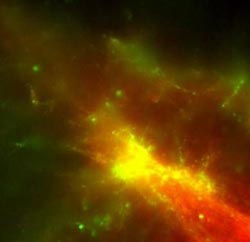All aboard the nanotrain network

Nanotrain network created by scientists at Oxford University: green dye-carrying shuttles after 'refuelling' with ATP travel towards the center of the network with their cargoes of green dye.<br><br>Credit: Adam Wollman/Oxford University<br>
The system can construct its own network of tracks spanning tens of micrometres in length, transport cargo across the network and even dismantle the tracks.
The work is published in Nature Nanotechnology and was supported by the Engineering and Physical Sciences Research Council and the Biotechnology and Biological Sciences Research Council.
Researchers were inspired by the melanophore, used by fish cells to control their colour. Tracks in the network all come from a central point, like the spokes of a bicycle wheel. Motor proteins transport pigment around the network, either concentrating it in the centre or spreading it throughout the network. Concentrating pigment in the centre makes the cells lighter, as the surrounding space is left empty and transparent.
The system developed by the Oxford University team is very similar, and is built from DNA and a motor protein called kinesin. Powered by ATP fuel, kinesins move along the micro-tracks carrying control modules made from short strands of DNA. 'Assembler' nanobots are made with two kinesin proteins, allowing them to move tracks around to assemble the network, whereas the 'shuttles' only need one kinesin protein to travel along the tracks.
'DNA is an excellent building block for constructing synthetic molecular systems, as we can program it to do whatever we need,' said Adam Wollman, who conducted the research at Oxford University's Department of Physics. 'We design the chemical structures of the DNA strands to control how they interact with each other. The shuttles can be used to either carry cargo or deliver signals to tell other shuttles what to do.
'We first use assemblers to arrange the track into 'spokes', triggered by the introduction of ATP. We then send in shuttles with fluorescent green cargo which spread out across the track, covering it evenly. When we add more ATP, the shuttles all cluster in the centre of the track where the spokes meet. Next, we send signal shuttles along the tracks to tell the cargo-carrying shuttles to release the fluorescent cargo into the environment, where it disperses. We can also send shuttles programmed with 'dismantle' signals to the central hub, telling the tracks to break up.'
This demonstration used fluorescent green dyes as cargo, but the same methods could be applied to other compounds. As well as colour changes, spoke-like track systems could be used to speed up chemical reactions by bringing the necessary compounds together at the central hub. More broadly, using DNA to control motor proteins could enable the development of more sophisticated self-assembling systems for a wide variety of applications.
Media Contact
More Information:
http://www.ox.ac.ukAll latest news from the category: Life Sciences and Chemistry
Articles and reports from the Life Sciences and chemistry area deal with applied and basic research into modern biology, chemistry and human medicine.
Valuable information can be found on a range of life sciences fields including bacteriology, biochemistry, bionics, bioinformatics, biophysics, biotechnology, genetics, geobotany, human biology, marine biology, microbiology, molecular biology, cellular biology, zoology, bioinorganic chemistry, microchemistry and environmental chemistry.
Newest articles

Machine learning algorithm reveals long-theorized glass phase in crystal
Scientists have found evidence of an elusive, glassy phase of matter that emerges when a crystal’s perfect internal pattern is disrupted. X-ray technology and machine learning converge to shed light…

Mapping plant functional diversity from space
HKU ecologists revolutionize ecosystem monitoring with novel field-satellite integration. An international team of researchers, led by Professor Jin WU from the School of Biological Sciences at The University of Hong…

Inverters with constant full load capability
…enable an increase in the performance of electric drives. Overheating components significantly limit the performance of drivetrains in electric vehicles. Inverters in particular are subject to a high thermal load,…





















